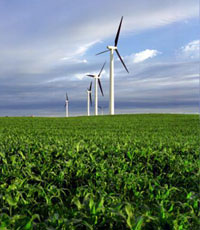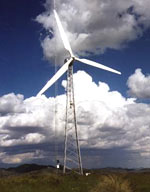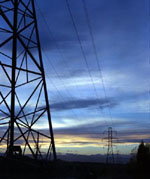|
作者:萊斯特•布朗2000年8月21日
美國的農民和農場經營者已漸漸發現,他們擁有的不只是土地,還有權利用土地上吹過的風。一位在愛荷華州的農夫租得一塊不足一英畝的地,設置一座風車專門用來發電,一年就能輕鬆賺到美金2000元。而同樣一塊地在風調雨順的好年,一年只能生產出價值美金100元的玉米。

雙重耕耘,喜悅加倍圖:國家再生能源實驗室(NREL) 網路影像資料庫(PIX)
間隔適宜、成列豎立在農田裡的風車,能為農民帶來滾滾財源,一年到頭都不虞匱乏。當農夫們正為剝削的農作物價格苦苦奮鬥時,某些人已從這個「新品種」中找到一條生路,讓他們能守住自己的本行。這就好比挖到石油,唯一不同的是,風是採也採不完的。
在北美洲大平原,一英畝的牧場一年僅能生產出美金20元的牛肉,換作種植小麥或許能賣到美金120元,風力發電的魅力可見一般。擁有主力風車發電廠的牧場,其年收入輕易地便遠遠超出牲口的販賣所得。
風能利用的效益與日俱增。根據美國風能學會的報告顯示,每千瓦/小時的風力發電成本,已從1980年代早期的(美金)38分,降至今日的3~6分錢。風力發電的成本與其他發電方式相比,不但已具競爭力,預期還會持續降低。憑著先進的風車設計不斷降低成本,不難推測為何風力發電轉瞬間蔚為風氣,更勝於其加州的發源地。
當風車農場進駐愛荷華州、明尼蘇達州、德州和懷俄明州等農耕、畜牧區後,風力發電從此勢不可擋,令全美的風力發電量從1998年的1,928兆瓦激增到1999年的2,490兆瓦,成長了29%,風力發電的潛力實在驚人。美國能源部的一項風力資源清單發現,北達科他、堪薩斯及德州這三個地方可資利用的風能,便已足夠供應全美的用電需求量。
大風吹,吹什麼
散佈在農田或牧場裡的風車,完全不會妨礙到農地耕作或牲口放牧,這便是風能的魅力之一,農牧業者可充分享有實質的土地利用和利益。

高效能風力發電農場圖:NREL/PIX
風能另一個吸引人的地方,就是利潤所得不落外人田,不像石油火力發電廠,收取的電費最後都進了中東國家的財庫。單是一座大型風車,一年如生產折合美金10萬元以上的電力,善用自國的風能便可振興農業。
農地價值不久將反映出這項新的財源。相較於過去左右能源經濟的石油探測學家,判定風車最佳設置地點的風象學者,如今在新舊能源經濟易位的過程中,扮演著決定性的角色。風象學家在某地區裝設測風儀器的小動作,就能引起該區的地價上揚。
風力發電不僅對私人的農場有利,更可為國家帶來財源、創造工作機會和稅收。第一座在加州以外地區設置的公營風力發電廠,已於日前在玉米帶耕作區的精華地帶「第三平原」開始運作。
低廉的風力發電,亦可用來電解水質、製造出當今廣受看好的未來燃料──氫氣。隨著電動汽車預期將在未來數年內上市,屆時可選擇使用氫氣作為燃料,一個廣大的新市場將指日可待。汽車燃料供應的龍頭業者皇家荷蘭(殼牌)石油公司,便已開始在歐洲著手設立氫氣加油站了。
或許有那麼一天,美國的農場和牧場未將可完全供應國內車輛所需的氫氣燃料,並滿足一切用電需求,讓美國向中東石油國家宣布獨立。
吾友,且看風兒為我們解答
隨著石化燃料對地球氣候影響的問題受到重視,各層級的政府單位也開始在某些州鼓勵實施氣候良性效應再生資源的發展計畫,並要求民間的委託單位提供消費者「綠色能源」的選擇。雖然成效往往只換來每個月略有所漲的電費帳單,許多擔心氣候變化的民眾,依然寧可選擇綠色能源。

你知道電從哪裡來嗎?圖:NREL/PIX
在科羅拉多州,由於民眾和企業均可選擇使用風力發電,已使得當地的風力發電量達到20兆瓦,且在不久後將可望增加為兩倍。明尼蘇達州最大的一座風力發力發電廠預計在2002年以前,將可達到425兆瓦的發電量。德州的立法院會已決定,要在2009年以前達到再生資源發電量超過2,000兆瓦的目標,其中來自孤星州(德州的別稱)的大量風力,將會是最主要的發電資源。
在聯邦政府方面,美國能源部長比爾•理查森則要求該部門於2010年以前,做到7.5%的用電須來自非水力發電的再生資源。
風力發電的支持者正形成一股強大勢力。農民和消費者如今加入環保人士的行列,共同推動國家的風力資源發展,連帶的,美國中西部和美洲大平原境內農業、畜牧業盛行的各州民意代表們,也在華盛頓首府的立法院會裡,提議增列風能優惠稅率,以鼓勵外界對風力發電的投資。風能除了經濟面的利益之外,新聞報導成天探討熱浪、旱災、冰河溶化及海水量升高等種種地球變溫可能產生的效應問題,政治利益也在媒體的炒作下掀起高潮。

蒙古的風車圖:威廉•華樂士,NREL/PIX
風力發電的快速成長,並不只限於美國。1999年全世界的風力發電量,巨幅成長了39%。丹麥的風能電力供應已達10%;德國最北部的什列斯威霍斯坦州,其風力發電量便佔全國電力總量約14%;西班牙北部的工業區拿瓦拉省,其風力發電量佔總用電量從0增加至23%,前後不過才四年的時間。中國直到最近才在內蒙古開闢一座風力發電農場,根據風象分析師的預測,中國的風能潛力足以製造出全國總發電量兩倍的量。
在丹麥、德國和荷蘭,無論自耕農或農業公會,均主動投資風車設備,並對當地社區有價供應電力,藉由風力發電,為農民生計廣闢財源。
世界才剛開始體認到風的好處:一種取之不盡、用之不竭的能源,農民尚在學習兩種收獲比一種好的道理;政治領導者漸漸了解風能既無能源安全和氣候穩定性的顧慮,消費者發現他們也能為穩定氣候盡一份心力。這種多方共識的贏贏格局,將能推助風力成為新能源經濟的基石。
本文作者萊斯特•布朗是美國華盛頓特區的「世界守望會」之創辦人兼董事長
全文及圖示詳見: http://www.gristmagazine.com/grist/
imho/imho082100.stm
版權歸屬 地球日Grist magazine 環境信託基金會 (張正慈 譯,周曉雯審校)
中英對照全文:http://news.ngo.org.tw/issue/energy/
sub-energy00082901.htm |
|
Farmers are reaping rewards from wind energy
By Lester R. Brown08.21.00
Farmers and ranchers in the United States are discovering that they own not only land, but also the wind rights that accompany it. A farmer in lowa who can typically earn $2,000 a year in royalties from the electricity produced In a good year, that same plot can produce $100 worth of corn.
Double your pleasure -- two different crops.Photo: NREL/PIX.
Wind turbines strung across a farm at appropriate intervals can provide a welcome boost to farm income, yielding a year-round cash flow. At a time when farmers are struggling with low grain prices, some are now finding salvation in this new "crop," enabling them to stay on their land. It is like striking oil, except that the wind is never depleted.
In the Great Plains, where an acre of rangeland produces only $20 worth of beef a year or where an acre planted in wheat may yield $120, the attraction of wind power is obvious. For ranchers with prime wind sites, income from wind could easily exceed that from cattle sales.
Harnessing the wind has become increasingly profitable. The American Wind Energy Association reports that the cost per kilowatt-hour of wind-generated electricity has fallen from 38 cents in the early 1980s to 3 to 6 cents today. Already competitive with other sources, the cost of wind-generated electricity is expected to continue to decline. These falling costs, facilitated by advances in wind turbine design, help explain why wind power is expanding rapidly beyond its original stronghold in California.
As wind farms have come into operation in farming and ranching states such as Iowa, Minnesota, Texas, and Wyoming, wind electric generation has soared, pushing U.S. wind-generating capacity from 1,928 megawatts in 1998 to 2,490 megawatts in 1999 -- a gain of 29 percent. The potential of wind power is enormous. A U.S. Department of Energy wind resource inventory found that three states -- North Dakota, Kansas, and Texas -- have enough harnessable wind energy to meet electricity needs for the whole country.
Blow by Blow
One of the attractions of wind energy is that the turbines scattered across a farm or ranch do not interfere with the use of the land for farming or cattle grazing. Farmers can literally have their cake and eat it too.
A high-powered crop.Photo: NREL/PIX.
Another attraction is that much of the income generated stays in local communities, whereas the money spent for electricity from an oil-fired power plant may go to the Middle East. With a single large turbine generating $100,000 or more worth of electricity per year, harnessing local wind energy can revitalize rural communities.
Agricultural land values may soon reflect this new source of income. The wind meteorologist who identifies the best sites for turbines is playing a role in the emerging new energy economy comparable to that of the petroleum geologist in the old energy economy. The mere sight of a wind meteorologist installing wind-measuring instruments in a community could raise land prices.
And it is not only the wind farms themselves that provide income, jobs, and tax revenue. The first utility-scale wind-turbine manufacturing facility outside of California recently started operation in Champaign, Ill., the heart of the Corn Belt.
Cheap electricity produced from wind can also be used to electrolyze water, thereby producing hydrogen, which is now widely viewed as the fuel of the future. With automobiles powered by fuel-cell engines expected on the market within a few years, and with hydrogen as the fuel of choice for these engines, a huge new market is opening up. Royal Dutch Shell, a leader in this area, is already starting to open hydrogen stations in Europe.
Farms and ranches may one day supply the hydrogen that will power the nation's motor vehicle fleet, giving the U.S. the energy source needed to declare its independence from Middle Eastern oil.
The Answer, My Friend, Is Blowin' in the Wind
As concerns rise about the burning of fuels that destabilize the climate, governments at all levels are beginning to encourage the development of climate-benign renewable energy sources. In some states, utility commissions are requiring utilities to offer their customers a "green power" option. Although this usually means a slightly higher monthly electricity bill, many citizens worried about climate change are choosing green power.
Do you know where your power comes from?Photo: NREL/PIX
In Colorado, a wind power option available to both residential and business electricity users has already led to the installation of 20 megawatts of wind-generating capacity -- an amount expected to double soon. Minnesota is requiring its largest utility to install 425 megawatts of wind-generating capacity by 2002. In Texas, the legislature has set a goal of 2,000 megawatts of generating capacity from renewable sources by 2009, with most of that expected to come from the Lone Star State's abundant wind resources.
At the national level, U.S. Secretary of Energy Bill Richardson is requiring that 7.5 percent of the electricity used by his department come from non-hydro renewable sources by 2010.
A formidable new alliance is emerging in support of wind energy. Farmers and consumers are now joining environmentalists in supporting the development of the nation's wind wealth. So, too, are political leaders in the farming and ranching states of the Midwest and the Great Plains, many of whom sponsored legislation in Washington to extend the wind energy tax credit, which encourages investment in wind power. Aside from the economic benefits of wind energy, political interest is being spurred by a steady diet of news stories about the possible effects of global warming, including record heat waves and droughts, melting glaciers, and rising sea levels.
Wind power, Mongolia-style.Photo: William Wallace, NREL/PIX.
Rapid growth in wind energy is not limited to the U.S. Worldwide, wind electric generation in 1999 expanded by a staggering 39 percent. Wind already supplies 10 percent of Denmark's electricity. In Germany's northernmost state of Schleswig-Holstein, it supplies some 14 percent of all electricity. Spain's northern industrial province of Navarra gets 23 percent of its electricity from wind, up from zero just four years ago. In China, which recently opened its first wind farm in Inner Mongolia, wind analysts estimate that the country's wind potential is sufficient to double national electricity generation.
In Denmark, Germany, and the Netherlands, individual farmers or organized groups of farmers are investing in turbines themselves and selling electricity to the local utilities, thus boosting the farmers' share of income from wind power.
The world is beginning to recognize wind for what it is -- an inexhaustible energy source. Farmers are learning that two crops are better than one, political leaders are realizing that harnessing the wind can contribute to both energy security and climate stability, and consumers are finding out that they can help stabilize the climate. This is a winning combination -- one that will help make wind a cornerstone of the new energy economy.
Lester R. Brown is founder and chair of the board of the Worldwatch Institute in Washington, D.C.
http://www.gristmagazine.com/grist/
imho/imho082100.stm |
